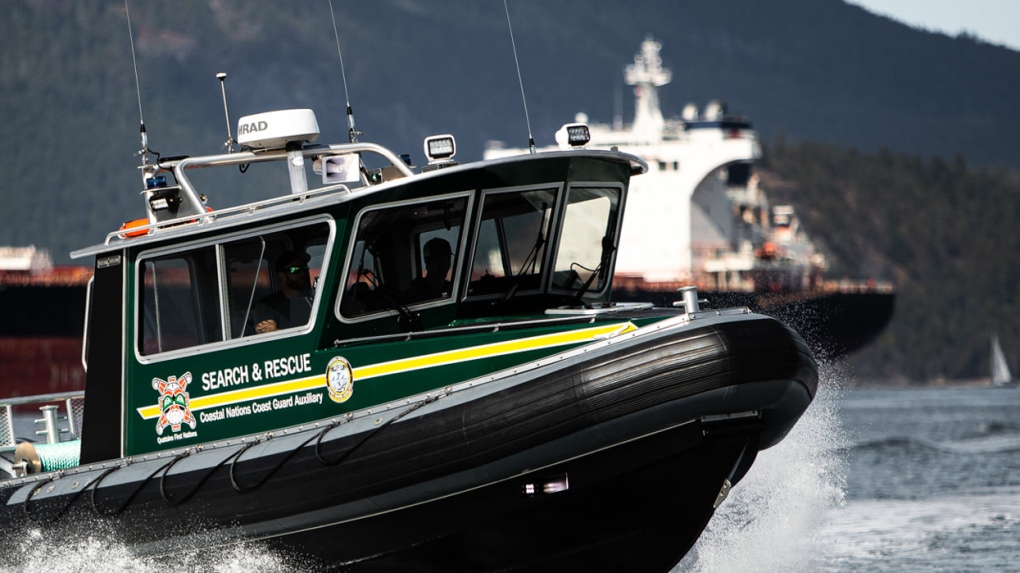B.C. First Nations partner with coast guard to launch 2 new marine response vessels
 The Quatsino First Nation’s response vessel, the Quatsino Spirit, is pictured. (Canadian Coast Guard / Facebook)
The Quatsino First Nation’s response vessel, the Quatsino Spirit, is pictured. (Canadian Coast Guard / Facebook)
Two coastal B.C. First Nations have partnered with the Canadian Coast Guard to launch two marine rescue vessels through the Coastal Nations Coast Guard Auxiliary (CN-CGA).
The Quatsino First Nation on northern Vancouver Island and the Kitasoo Xai'xais Nation, on Swindle Island, will work and train with the Canadian Coast guard to provide marine rescue response within their traditional territories.
The Quatsino First Nation’s new response vessel, the Quatsino Spirit, measures 8.2 metres (27 feet) long and can travel at 44.5 knots.
The vessel is already in service, and has been used in two search and rescue training exercises with the Canadian Coast Guard.
Meanwhile, the Kitasoo Xai'xais Nation's new emergency vessel, the Ksm Wutsi'in (Mousewoman), measures 9.1 metres long (30 feet) and has a cruising speed of 25 knots.
The Ksm Wutsi'in will operate in the Great Bear Rainforest area, according to the Coast Guard.
"Indigenous communities like Quatsino First Nation and Kitasoo Xai’xais Nation are often first on scene in a marine emergency," said Joyce Murray, Minister of Fisheries, Oceans and the Canadian Coast Guard.
"Funding for these community response vessels is one way our government is helping making the coast of British Columbia safer," she said.
The Coastal Nations Coast Guard Auxiliary is staffed entirely by Indigenous peoples, with more than 50 members from seven First Nations.
Last year, the Ahousaht First Nation on Vancouver Island launched its own $214,000 emergency response vessel funded through the federal government for the CN-CGA.
All CN-CGA volunteers practice with the Canadian Coast Guard and are trained in cold water rescue, marine first aid, search techniques, emergency communications protocols, and the use of specialized rescue equipment.
The volunteers are on call around the clock in some of the most remote regions of British Columba.
"As coastal Indigenous people, Kitasoo Xai'xais Nation have been responding to mariners in distress for thousands of years, whether those in need of rescue come from our Nations, or are guests to our waters," said Doug Fraser, Kitasoo Xai'xais First Nations CN-CGA board director.
"Having a dedicated search and rescue vessel will potentially help rescue more people and protect the lives of rescuers."
CTVNews.ca Top Stories

W5 Investigates Canada's least wanted man: A family's long and lonely fight to bring their son home from Syria
Counterterrorism experts and humanitarian groups are urging countries to repatriate suspected ISIS members, as one family tells CTV W5 about their long and lonely fight to bring their son home from Syria.
After warmest on record, winter looks to 'salvage its reputation': Weather Network
Canada's warmest winter on record is unlikely to make a repeat performance this year, The Weather Network's chief meteorologist says, as a new seasonal forecast suggests the season will try to 'salvage its reputation.'
Canadians carrying more debt and missing more payments: reports
Interest rate cuts by the Bank of Canada appear to have stimulated spending with more consumers taking on added debt, but as more people take on more credit and car loans there's also been an increase in delinquency rates.
Israel-Hezbollah ceasefire appears to hold as Lebanese begin streaming south to their homes
A ceasefire between Israel and the Lebanese militant group Hezbollah that began Wednesday appeared to be holding, as residents in cars heaped with belongings streamed back toward southern Lebanon despite warnings from the Israeli and Lebanese militaries that they stay away from certain areas.
'It's intimidation': Vancouver councillors told to stop displaying children's artwork during meeting
Two Vancouver city councillors were told to remove children's artwork from their desks during Tuesday's meeting, after one of their colleagues called the display of the drawings "intimidating."
Canada approves Novo Nordisk's obesity drug to reduce risk of non-fatal heart attack
Canada's health regulator has approved Novo Nordisk's weight loss drug Wegovy to reduce the risk of nonfatal heart attack or myocardial infarction in some adults, the Danish drugmaker said on Wednesday.
N.S. Progressive Conservatives win second majority government; NDP to form opposition
For the second time in a row, Tim Houston's Progressive Conservatives have won a majority government in Nova Scotia. But this time, the NDP will form the official opposition.
The son of Norway's crown princess to be released from custody in rape allegations
The eldest son of Norwegian Crown Princess Mette-Marit is to be released from custody after his arrest last week on rape allegations, Norwegian broadcaster NRK reported Wednesday.
A fugitive wanted in the U.S. for a pair of bombings is arrested in the U.K. after 20 years on the run
A suspected animal rights extremist wanted in the U.S. for bombings in the San Francisco area was arrested in Britain after more than 20 years on the run from the law, officials said Tuesday.


































